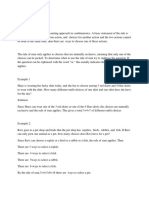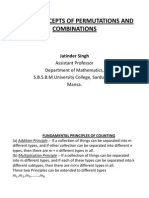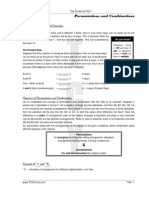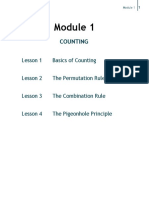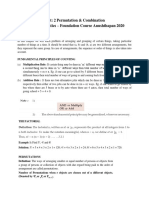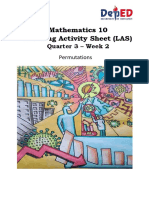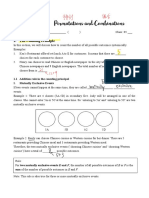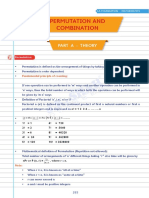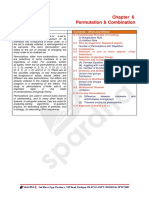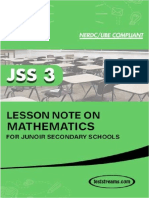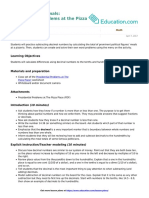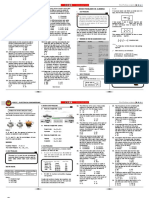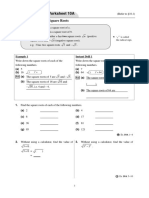MATH
Permutation & Combination
Every Year 1 Crore Students Trust Us for Test Prep
https://hitbullseye.com/courses.php 1800-572-7346
m
L
eo
Lr
� PERMUTATION & COMBINATION
Fundamental Principle of Counting
Multiplication: If there are two jobs such that one of
them can be completed in m ways, and when it has been
completed in any one of these m ways, second job can
be completed in n ways, then the two jobs in succession
can be completed in m × n ways.
Ex.1 In a class there are 10 boys and 8 girls. The teacher
wants to select a boy and a girl to represent the
class in a function. In how many ways can the
teacher make the selection?
Sol. Here the teacher has to perform two jobs.
(i) Selecting a boy among 10 boys and
(ii) Selecting a girl among 8 girls.
The first of these can be performed in 10 ways and
the second in 8 ways. Therefore by the
fundamental principle of multiplication, the
required number of ways is 10 × 8 = 80.
Addition: If there are two jobs such that they can be
performed independently in m and n ways respectively,
then either of the two jobs can be performed in (m + n)
ways.
1
�Ex.2 In a class there are 10 boys and 8 girls. The teacher
wants to select a boy or a girl to represent the
class in a function. In how many ways the teacher
can make the selection?
Sol. Here the teacher has to perform either of the
following two jobs.
(i) Selecting a boy among 10 boys or
(ii) Selecting a girl among 8 girls.
The first of these can be performed in 10 ways and
the second in 8 ways. Therefore, by fundamental
principle of addition either of the two jobs can be
performed in 10 + 8 = 18 ways. Hence the teacher
can make the selection of either a boy or a girl in
18 ways.
Note: The above principles of counting can be extended
to any finite number of jobs.
Permutations
Each of the arrangement which can be made by taking
some or all of a number of things is called a permutation.
Ex.3 The permutation of three letters A, B, C.
Sol. The permutation of three letters A, B, C taking all at
a time are ABC, ACB, BCA, CBA, CAB, BAC
2
�Ex.4 The permutation of three letters A, B, C taken two a
time.
Sol. The required permutations are AB, BA, BC, CB, AC,
CA.
Permutation of n distinct objects taken ‘r’ at a time
{Here r and n are positive integers & 1 r n} is = P(n, r)
= n Pr = n (n – 1) (n – 2) _ _ _ _ _ (n – r + 1)
n!
Note–1: P(n, r) = n
Pr =
(n r )!
Ex.5 In how many ways can three different rings be
worn in four fingers with at most one in each
finger?
Sol. The total number of ways is same as the number of
arrangements of 4 fingers taken 3 at a time. So
required number of ways = 4 P3 4! 4! = 4! = 24.
4 3! 1!
The above illustration can also be explained by
presuming the three rings as R1, R2 and R3
First Ring R1 can be worn in 4 ways
Now Ring R2 can be worn in 3 ways
And Ring R3 can be worn in 2 ways
3
� By the fundamental principle of counting the total
number of way in which three different rings can be
worn in four fingers = 4 × 3 × 2 ways = 24 ways
Permutation of ‘n’ distinct objects taken all at a
time
(Here n is a positive integer) is P(n, n) = nPn = n!
n! n!
Note: P(n, n) = n! = 0! = 1.
(n n)! 0!
Hence zero factorial is 1.
Ex.6 How many words with or without meaning can be
formed using all the letters of the word EQUATION,
using each letter exactly once.
Sol. There are 8 letters in the word EQUATION. So the
total number of words is equal to the number of
arrangements of these letters, taken all at a time.
The number of such arrangements is 8P8 = 8!
Permutation of ‘n’ different objects, taken ‘r’ at a time,
when a particular objects is to be always included in each
arrangement is ‘r’. n-1Pr-1
Ex.7 How many four lettered words, with or without
meaning, can be formed using the letters of the
4
� word ‘MOTHERLY’ using each letter exactly once
having essentially ‘M’ as one of the letters.
Sol. (i) Number of four letters words beginning with ‘M’
=8-1P4-1
(ii) Number of four letters words having ‘M’ as 2nd
letter = 8-1P4-1
(iii) Number of four letters words having ‘M’ as 3rd
letter = 8-1P4-1
(iv) Number of four letters words having ‘M’ as last
letter = 8-1P4-1
Total number of words
= 8-1P4-1 + 8-1P4-1 + 8-1P4-1 + 8-1P4-1 = 4. 8-1P4-1
Permutation of ‘n’ distinct objects taken ‘r’ at time when a
particular object is never taken in each arrangement is
n-1
Pr. Here one particular object out of n given objects is
never taken. So we have to determine the number of
ways in which r places can be filled with (n – 1) distinct
objects. Clearly the number of arrangement is n 1 Pr .
Ex.8 How many four letters words with or without
meaning can be formed using the letters of the
5
� word EQUATION using each letter exactly once.
The words are not to have ‘N’ as one of the letters.
Sol. Here the total numbers of objects is the numbers
of letters of the word EQUATION which is = 8.
We can arrange only (8 – 1) objects taken 4 at a
time.
Required number of ways = 8-1P4 = 7P4.
Permutation of ‘n’ different objects taken ‘r’ at a time in
which two specified objects always occur together is 2! (r
– 1) n-2Pr-2. Here if leave out two specified objects, then
the number of permutations of the remaining (n – 2)
objects, taken (r – 2) at a time is n-2Pr-2. Now consider two
specified objects temporarily as a single object and add
to each of these n-2Pr-2 permutations which can be done is
(r – 1) ways. Thus the number of permutations becomes
(r – 1) n-2Pr-2. But the two specified things can be put
together in 2! ways. Hence the required no. of
permutations is 2! (r – 1) n-2Pr-2.
Ex.9 In how many ways can letters of the word PENCIL
be arranged so that E and N are always together?
Sol. Let us keep EN together and consider as one letter.
Now we have 5 letters which can be arranged in 5P5
= 5! = 120 ways. But E and N can be put together in
6
� 2! ways (EN or NE). Hence total no. of ways = 2!
5! = 240 ways.
Permutation of objects not all distinct: till now we have
been discussing permutations of distinct objects by
taking some or all at a time. Now we will discuss the
permutations of a given number of objects when objects
are not all different. The number of mutually
distinguishable permutations of ‘n’ things, taken all at a
time, of which p are alike of one kind, q are alike of
second such that p + q = n is n!
p! q!
Ex.10 How many different words can be formed with the
letters aaaaiiiippf?
Sol. There are 11 letters in the given word of which 4
are as, 4 are is and 2 are p’s. So total number of
words is the arrangement of 11 things, of which 4
are alike of one kind, 4 are alike of second kind and
2 are alike of third kind i.e. 11! . Hence total
4!4!2!
number of words = 11!
= 34,650.
4!4!2!
Permutation when objects can repeat the number of
permutations of n different things, taken r at a time,
when each may be repeated any number of times in each
arrangement is nr.
7
�The concept can be explained by comparing this
permutation with the number of ways in which r places
can be filled in by n different things when each thing can
be repeated r times.
The first places can be filled in n ways by any one of the
n things. Having filled up the first place n things are
again left, therefore the second place can be filled in n
ways.
Similarly each of the 3rd, 4th, _ _ _ _ rth place can be filled
in n ways. Thus by fundamental principle of counting, the
total number of ways of filling ‘r’ places = n × n × n _ _ _ _
_ _ to r factors = nr
Ex.11 In how many ways can 5 letters be posted in 4
letter boxes?
Sol. Since each letter can be posted in any one of the
four letter boxes. So a letter can be posted in 4
ways. So total number of ways in which all five
letters can be posted = 4 4 4 4 4 = 45 ways.
Difference Between Permutation & Combination
(i) In a combination only selection is made whereas in
permutation, not only a selection is made but also
an arrangement in a definite order is considered.
8
�(ii) In a combination the ordering of selected objects is
immaterial whereas in a permutation, the ordering
is essential
(iii) Practically to find the permutations of n different
items, taken ‘r’ at a time, we first select r items
from n items and then arrange them. So usually,
the number of permutations exceeds the
combinations.
Combination of n different objects, taken r at a time is
n!
given by C(n, r) n
Cr =
(n r )!r !
Ex.12 Out of 5 men & 2 women, a committee of 3 is to be
formed. In how many ways can it be done if at least
one woman is to be included?
Sol. The committee can be formed in the following
ways.
(i) By selecting 2 Men and 1 Woman.
(ii) By selecting 1 Man and 2 Women
2 men out of 5 men and 1 woman out of 2 women
can be chosen in 5C2 × 2C1 ways and 1 men out of 5
men and 2 women out of 2 women can be chose in
5
C1 × 2C2 ways.
9
� Total number of ways of forming the committee
= 5C2 × 2C1 + 5C1 × 2C2 + = 20 + 5 = 25.
Properties of n C r
Prop–I n C r = n C n - r for 0 r n
Prop–II Let n and r be non–negative integers such that r
n. Then nCr + nCr-1 = n+1Cr
Prop–III Let n and r be non–negative integers such that
n
1 r n. Then n Cr . n 1Cr 1
r
Division of Items into Groups
Division of items into groups of unequal sizes: Number
of ways in which (m + n) items can be divided into two
unequal groups containing ‘m’ and ‘n’ items is (m n)! .
m! n!
Note: The number of ways in which (m + n) items are
divided into two groups containing ‘m’ and ‘n’ items is
same as the number of combinations of (m + n) things.
( m n)!
Thus the required number = mn
Cm = .
m !n !
Note: The number of ways of dividing (m + n + p) items
among 3 groups of size m, n and p respectively is
m n p !
= (Number of ways to divide) =
m !n ! p !
10
�Note: The number of ways in which mn different items
can be divided equally into m groups each containing n
objects and the order of group is important is
mn ! 1 mn ! .
m !
n! n!m
m
m!
Note: The number of ways in which (mn) different items
can be divided equally into m groups each containing n
objects and the order of groups is not important
is mnm! 1 .
n! m!
More Solved Examples
Ex.1 Find the LCM of 4!, 5! and 6!.
Sol. We have 5! = 5 4! and 6! = 6 5 4!
LCM of 4!, 5! and 6! = LCM of 4!, 5 4! and 6 5
4! = (4!) 5 6 = 6! = 720.
n! n!
Ex.2 If and are in the ratio of 2 : 1, find
2!(n 2)! 4! n 4 !
the value of n.
n!
Sol. We have . n!
=2:1
2!(n 2)! 4!(n 4)!
n! 4!(n 4)! 2
= (n – 2) (n – 3) = 6
2!(n 2)! n! 1
11
� n2 – 5n = 0 n = 0, 5. For n = 0 (n – 2)! and (n –
4)! are not meaningful. n = 5
Ex.3 Prove that (n! + 1) is not divisible by any natural
number between 2 and n.
Sol. Let m be divisible by k . Let r be any natural number
between 1 and k. If (m + r) is divided by k, then we
obtain r as the remainder. Since n! = 1.2.3.4_ _ _ _ _
(n – 1).n, it follows that n! is divisible by every
natural number between 2 and n. So (n! + 1) when
divided by any natural number between 2 and n,
leaves 1 as the remainder. Hence (n! + 1) is not
divisible by any natural number between 2 and n.
Ex.4 How many four digit numbers can be formed using
the digits 0, 1, 2, 3, 4, 5 if
(i) Repetition of digits is not allowed
(ii) Repetition of digits is allowed?
Sol. (i) In a four digit number 0 can’t appear in the
thousand’s place. So thousand’s place can be filled
in 5 ways (viz 1, 2, 3, 4, 5). Since repetition of digits
is not allowed and 0 can be used at hundred’s
place, so hundred’s place can be filled in 5 ways.
12
� Now any one of the remaining four digits can be
used to fill up ten’s place. So ten’s place can be
filled in 4 ways. One’s place be filled from the
remaining three digits in 3 ways. Hence the
required number of numbers = 5 × 5 × 4 × 3 = 300.
(ii) For a four digit number we have to fill up four
places and 0 cannot appear in the thousand’s
place. So thousand’s place can be filled in 5 ways.
Since repetition of digits is allowed, so each of the
three remaining places viz hundred’s, ten’s and
one’s can be filled in 6 ways.
Hence required number of numbers = 5 × 6 × 6 × 6
= 1,080.
Ex.5 It is required to seat 5 men and 4 women in a row
so that the women occupy the even places. How
many such arrangements are possible?
Sol. In all 9 persons are to be seated in a row and in the
row of a positions there are exactly four even
places viz. second, fourth, sixth and eighth. It is
given that these four even places are to be
occupied by 4 women. This can be done in 4P4
ways. The remaining 5 positions can be filled by
the 5 Men in 5P5 ways. So by the fundamental
principle of counting, the numbers of seating
13
� arrangements as required in 4P4 × 5P5 = 4! × 5! = 24
× 120 = 2,880.
Ex.6 How many words can be formed from the letters of
the word ‘DAUGHTER’ so that the vowels never
come together?
Sol. The total number of words formed by using all the
eight letters of the word ‘DAUGHTER’ is 8P8 = 8! =
40,320. So, the total number of words in which
vowels are never together = Total number of words
– Number of words in which vowels are together =
40,320 – 4,320 = 36,000
Ex.7 How many four digit numbers divisible by 4 can be
made with the digits 1, 2, 3, 4, 5 if the repetition of
digits is not allowed?
Sol. A number is divisible by 4 if the number formed by
the last two digits is divisible by 4.
So possible ways of last two places are 12,24,32
and 52.
Now corresponding each such way the remaining
three digits at thousand’s and hundred’s places
can be arranged in 3P2 ways. Hence the required
number of numbers = 3P2 × 4 = 3! × 4 = 24.
14
�Ex.8 How many words can be formed using the letter A
thrice, the letter B twice and the letter C thrice?
Sol. We are given 8 letters viz. A, A, A, B, B, C, C, C.
Clearly there are 8 letters of which three are of one
kind, two are of second kind and three are of third
kind. So the total number of permutations is =
8!
= 560. Hence the requisite number of words =
3!2!3!
560.
Ex.9 Find the number of ways in which a pack of 52
cards be divided into 4 sets, three of them having
17 cards and the fourth just one card?
Sol. First we divide 52 cards into two groups of 1 cards
52!
and 51 cards. This can be done in ways. Now
1!51!
every group of 51 cards can be divided into 3
51!
groups of 17 cards each is . Hence the
(17!)3 3!
required number of ways
52! 51! 52!
=
(51!)(1!) (17!) 3! (17!)3 3!
3
15

















